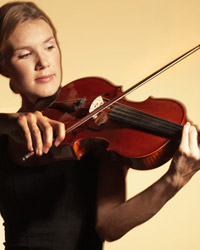instrument: Viola
 The viola is the alto-tenor (middle) member of the orchestral bowed string family, and a staple instrument within the history of classical music – since its appearance in the early 16th century. Like its musical relatives the violin, cello, and double bass, the viola has roots in the Medieval viol and rebec, or fiddle. See the entry on violin for the early development of the viola and other instruments of this family.
The viola is the alto-tenor (middle) member of the orchestral bowed string family, and a staple instrument within the history of classical music – since its appearance in the early 16th century. Like its musical relatives the violin, cello, and double bass, the viola has roots in the Medieval viol and rebec, or fiddle. See the entry on violin for the early development of the viola and other instruments of this family.
By the early Baroque era, the viola (in the modern sense) had become a staple of the string consort – indeed, it was generally the dominant instrument used in four- and five-part ensembles; large numbers were constructed in the 17th century, including by the famous Amati and Maggini families (less by Stradivari or Guarneri). However, the viola from the beginning enjoyed less solo attention than either the violin or the cello, witnessed by the near absence of viola concertos prior to that of Georg Philip Telemann, around 1720. Instead, the viola’s role was largely limited to playing less-distinguished middle or harmony parts within orchestral and chamber settings; indeed, it was excluded from the dominant forms of late-Baroque chamber music – the violin sonata and the trio sonata. During the Classical and early Romantic eras, however, the viola’s profile increased, particularly within chamber music, given it’s role within string trios, quartets, and quintets – by the great masters of the day, Franz Joseph Haydn, Wolfgang Amadeus Mozart, Ludwig van Beethoven, and Franz Schubert; though still less prominent than the violin or cello parts, composers increasingly distributed interesting and demanding musical material to the viola as well – as heard, for example, in Beethoven’s late quartets. Among more featured viola works of this period include Mozart's Sinfonia concertante in Eb, K.364 – for solo violin and viola, where the viola is tuned to Eb, giving it a pronounced brightness that rivals the violin.
During the Romantic era, the viola maintained it’s limited profile – with the only famous viola concerto being Hector Berlioz' Harold in Italy, Op.16. At the same time, much wonderful viola writing appears in the orchestral and chamber works of the great composers of the late-Romantic era – Johannes Brahms (whose two chamber sonatas, Op.120, were specified for clarinet or viola), Richard Wagner, Antonín Dvořák, Pyotr Tchaikovsky, Richard Strauss, Gustav Mahler, etc. Along the way, composers increased the technical demands of the instrument, a trend that continued manifestly in the Modern era. Indeed, the 20th century witnessed a particular increase in attention to the viola, both as a solo instrument – as in the viola concertos by Béla Bartók, Paul Hindemith, and William Walton, among others – and a prominent chamber instrument, particularly in string quartets, such as those by Maurice Ravel and Dimitri Shostakovich. Among Contemporary composers who have written prominently for the viola include Luciano Berio, Krzysztof Pendercki, and Alfred Schnittke.

Nolan Gasser, PhD
Artistic Director













